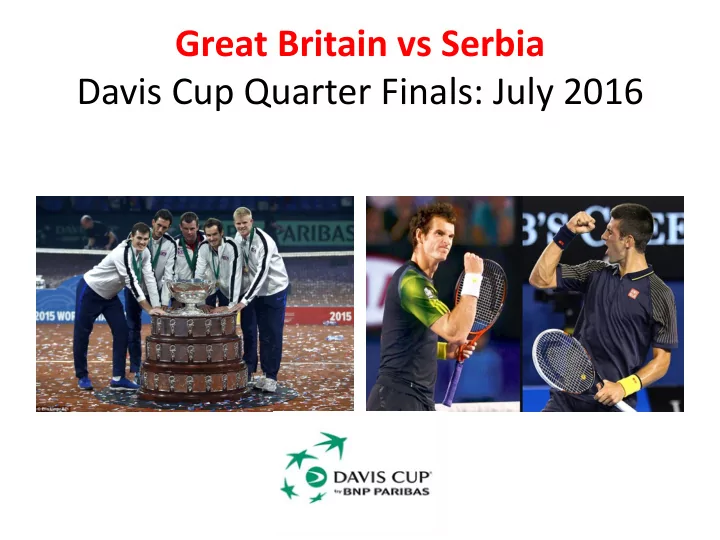

Great Britain vs Serbia Davis Cup Quarter Finals: July 2016
ACT-1 Results & CREST-1 Long-term Follow-up Richard Bulbulia Co-PI ACST-2 ACST-2 Collaborators Meeting Belgrade 21 st April 2016
ACT-1 1453 asymptomatic patients (US) Randomised to CAS vs CEA (3:1) Recruitment: 2005-2013 (Stopped - poor enrolment) Xact stent with embolic protection (Funder: Abbott) 5 year results available
ACT-1: Peri-procedural results CAS (1089) CEA (364) P Value Death, Stroke, MI 3.3% 2.6% 0.60 Death and Major Stroke 0.6% 0.6% 0.33 All Stroke 2.8% 1.4% 0.23 Major Stroke 0.5% 0.3% 1.00 Minor Stroke 2.4% 1.1% 0.20 MI 0.5% 0.9% 0.41 1. No significant difference for the primary outcome 2. Stroke rate doubled in CAS, driven by excess of minor strokes 3. MI rate doubled in CEA
ACT-1: 5-year post-procedural results Following a successful carotid procedure, both CEA and CAS appeared to offer similar durability Ipsilateral stroke rate: 2.2% CAS vs 2.7% CEA (P=0.51)
CREST-1 • 2502 patients (symptomatic and asymptomatic) • Randomised to CEA vs CAS • Recruitment: 2000-2008 in USA and Canada • RX Acculink stent (with embolic protection) • CEA and CAS were similar for primary outcome at 4 years (peri-procedural stroke, MI or death plus post-procedural ipsilateral stroke) • 10-year follow-up now available
CREST-1: Long-term Results 83 post-procedural ipsilateral strokes over 10 years Events Rate (%) HR (95% CI) P Value Total CAS 42 6.9 0.99 (0.64-1.52) 0.96 CEA 41 5.6 Major CAS 12 2.7 1.91 (0.71-5.10) 0.20 CEA 6 1.1 Minor CAS 30 4.2 0.83 (0.51-1.34) 0.44 CEA 35 4.5
CREST-1: Long-term Results 83 post-procedural ipsilateral strokes over 10 years Events Rate (%) HR (95% CI) P Value Total CAS 42 6.9 0.99 (0.64-1.52) 0.96 CEA 41 5.6 Major CAS 12 2.7 1.91 (0.71-5.10) 0.20 CEA 6 1.1 Minor CAS 30 4.2 0.83 (0.51-1.34) 0.44 CEA 35 4.5 Suggests equal durability for both CEA and CAS
CREST-1 Long-term Follow-up 5 year ipsilateral stroke rates by symptom status Symptomatic (95% CI) Asymptomatic (95% CI) CAS 2.5% (1.2-3.7) 2.5% (1.1-3.8) CEA 2.7% (1.9-4.9) 2.7% (1.8-4.9) Similar long-term stroke rates in both types of patient, and similar to the 5-year results in ACT-1
ACST-2 remains highly relevant ACT-1 results are non-informative CREST-1 suggests equivalence for CAS and CEA, But CI wide (0.64-1.52) ACST-2 will triple the evidence base for CEA vs CAS in asymptomatic patients, and help guide / change practice
ACST-2 Time Line April 2015: 2159 randomised End 2019: Randomise 3600 patients Median follow-up of 5 years Early 2020: Report peri-procedural (ie, early) risks and 5 year follow-up results IPD with CREST-1, ACT-1 and SPACE-2 by CSTC 6000 participants will allow meaningful subgroup analyses Mid 2025: Report 10-year follow-up results Reliably compare durability of CEA vs CAS NB: Long-term follow-up via postal questionnaires continues
Please keep randomising! Uncertainty Reliable Evidence
Recommend
More recommend